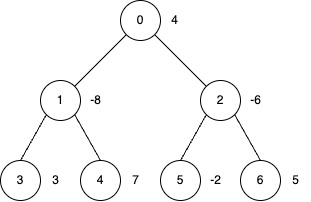LeetCode-in-Java
3544. Subtree Inversion Sum
Hard
You are given an undirected tree rooted at node 0, with n nodes numbered from 0 to n - 1. The tree is represented by a 2D integer array edges of length n - 1, where edges[i] = [ui, vi] indicates an edge between nodes ui and vi.
You are also given an integer array nums of length n, where nums[i] represents the value at node i, and an integer k.
You may perform inversion operations on a subset of nodes subject to the following rules:
-
Subtree Inversion Operation:
- When you invert a node, every value in the subtree rooted at that node is multiplied by -1.
-
Distance Constraint on Inversions:
-
You may only invert a node if it is “sufficiently far” from any other inverted node.
-
Specifically, if you invert two nodes
aandbsuch that one is an ancestor of the other (i.e., ifLCA(a, b) = aorLCA(a, b) = b), then the distance (the number of edges on the unique path between them) must be at leastk.
-
Return the maximum possible sum of the tree’s node values after applying inversion operations.
Example 1:
Input: edges = [[0,1],[0,2],[1,3],[1,4],[2,5],[2,6]], nums = [4,-8,-6,3,7,-2,5], k = 2
Output: 27
Explanation:

- Apply inversion operations at nodes 0, 3, 4 and 6.
- The final
numsarray is[-4, 8, 6, 3, 7, 2, 5], and the total sum is 27.
Example 2:
Input: edges = [[0,1],[1,2],[2,3],[3,4]], nums = [-1,3,-2,4,-5], k = 2
Output: 9
Explanation:

- Apply the inversion operation at node 4.
- The final
numsarray becomes[-1, 3, -2, 4, 5], and the total sum is 9.
Example 3:
Input: edges = [[0,1],[0,2]], nums = [0,-1,-2], k = 3
Output: 3
Explanation:
Apply inversion operations at nodes 1 and 2.
Constraints:
2 <= n <= 5 * 104edges.length == n - 1edges[i] = [ui, vi]0 <= ui, vi < nnums.length == n-5 * 104 <= nums[i] <= 5 * 1041 <= k <= 50- The input is generated such that
edgesrepresents a valid tree.
Solution
import java.util.ArrayList;
import java.util.List;
public class Solution {
private long[] totalSum;
private int[] nums;
private List<List<Integer>> nei;
private int k;
private long getTotalSum(int p, int cur) {
long res = nums[cur];
for (int c : nei.get(cur)) {
if (c == p) {
continue;
}
res += getTotalSum(cur, c);
}
totalSum[cur] = res;
return res;
}
private void add(long[][] a, long[][] b) {
for (int i = 0; i < a.length; i++) {
for (int j = 0; j < a[0].length; j++) {
a[i][j] += b[i][j];
}
}
}
private long[][] getMaxInc(int p, int cur) {
long[][] ret = new long[3][k];
for (int c : nei.get(cur)) {
if (c == p) {
continue;
}
add(ret, getMaxInc(cur, c));
}
long maxCandWithoutInv = nums[cur] + ret[2][0];
long maxCandWithInv = -(totalSum[cur] - ret[0][k - 1]) - ret[1][k - 1];
long minCandWithoutInv = nums[cur] + ret[1][0];
long minCandWithInv = -(totalSum[cur] - ret[0][k - 1]) - ret[2][k - 1];
long[][] res = new long[3][k];
for (int i = 0; i < k - 1; i++) {
res[0][i + 1] = ret[0][i];
res[1][i + 1] = ret[1][i];
res[2][i + 1] = ret[2][i];
}
res[0][0] = totalSum[cur];
res[1][0] =
Math.min(
Math.min(maxCandWithoutInv, maxCandWithInv),
Math.min(minCandWithoutInv, minCandWithInv));
res[2][0] =
Math.max(
Math.max(maxCandWithoutInv, maxCandWithInv),
Math.max(minCandWithoutInv, minCandWithInv));
return res;
}
public long subtreeInversionSum(int[][] edges, int[] nums, int k) {
totalSum = new long[nums.length];
this.nums = nums;
nei = new ArrayList<>();
this.k = k;
for (int i = 0; i < nums.length; i++) {
nei.add(new ArrayList<>());
}
for (int[] e : edges) {
nei.get(e[0]).add(e[1]);
nei.get(e[1]).add(e[0]);
}
getTotalSum(-1, 0);
long[][] res = getMaxInc(-1, 0);
return res[2][0];
}
}

